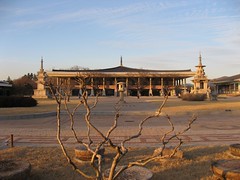


In keeping with the local theme, the museum also covered a wide area and was dispersed over four buildings, with the grounds housing a variety of ancient architectural objects and stones. There were many interesting exhibits and we spent about three hours working our way through. What's more, after my run-ins with the no-photo brigade over the last two days, it was encouraging to see that this museum merely asked its visitors to refrain from flash photography inside its buildings.
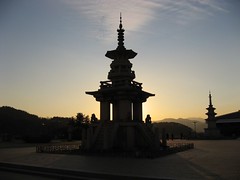
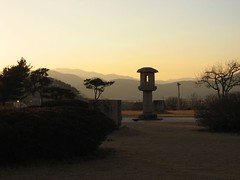
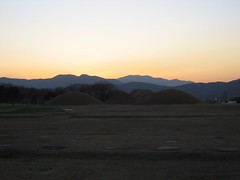
As we completed our tour the sun began to set over the museum grounds - we left and walked through a nearby park which contained the burial mounds of various kings - though I'm afraid I don't know what the park was called. Nearby, stands the Cheomseongdae Observatory - 'the oldest in the Orient' proclaims the guidebook, although to be honest, it's not much to look at during the daytime. As we were leaving and had walked some distance , the lights came on and made it look quite wonderful, but we were late for our ride home by this time and were too rushed to go back to take a shot.
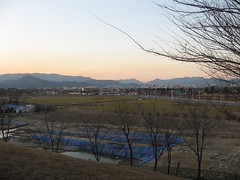
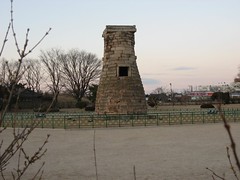

On our way to the museum we'd passed the 'Anapji Pond' area, which was an artificially created pond or lake in landscaped surroundings. Apparently it's beautiful in the summer but I don't think the winter season does it any favours as it seems rather bleak. We didn't go in.
Our final act of sightseeing in Gyeongju was to get lost. With no-one around to ask, we ended up trekking off in the direction we hoped was towards the city centre, but there were few clues to give this away. After going down and doubling back along a path through what seemed to be a very poor and haphazard area of Korean houses, we started to see lights in the distance as we went through a field beyond. As the path turned through some buildings at the far side of the fields, we were greeted to the sight of a busy road and neon lights out into the distance, and after a day of wide open spaces and not many people, I felt like a man walking out of the desert and back into civilisation.
The museum cost 1,000 won (about 54 pence) to enter and was really good value, but Anapji - which would only have taken us about fifteen minutes to walk round and wasn't very interesting given the season, was the same price. Cheomseongdae Observatory was 500 won - but it was a little bizarre given that you could walk within 10 meters of it for free. Most of the temples we'd visited the day before we around 4,000 won each - although a couple were cheaper. So, Gyeongju was a really cheap place to visit, although in the context of the pricing some places were much better value than others.
This was our last full day in Gyeongju and the next day we would head off back to Busan in the morning. Before I came I'd imagined Gyeongju, the capital of the ancient Silla Kingdom, to be like Nara in Japan - an ancient yet thriving city punctuated with scattered temples and historical sights, but it turned out that the Mongols had destroyed Gyeongju when they invaded and there wasn't much left of the old palaces and settlement in the central district. In the Museum there was a scale model of the old city, and an aerial shot of the geography today - it was mostly fields.
I never saw Gyeongju the city, whatever that is, and while I enjoyed my tour of Korean history - which I knew little about prior to this - I was only too glad to get back to civilisation. I realised that while I'm still drawn to Japan partly through an interest in Japanese history, the Korea I like is not the historical one but rather the one represented by the bright lights of Busan.
No comments:
Post a Comment